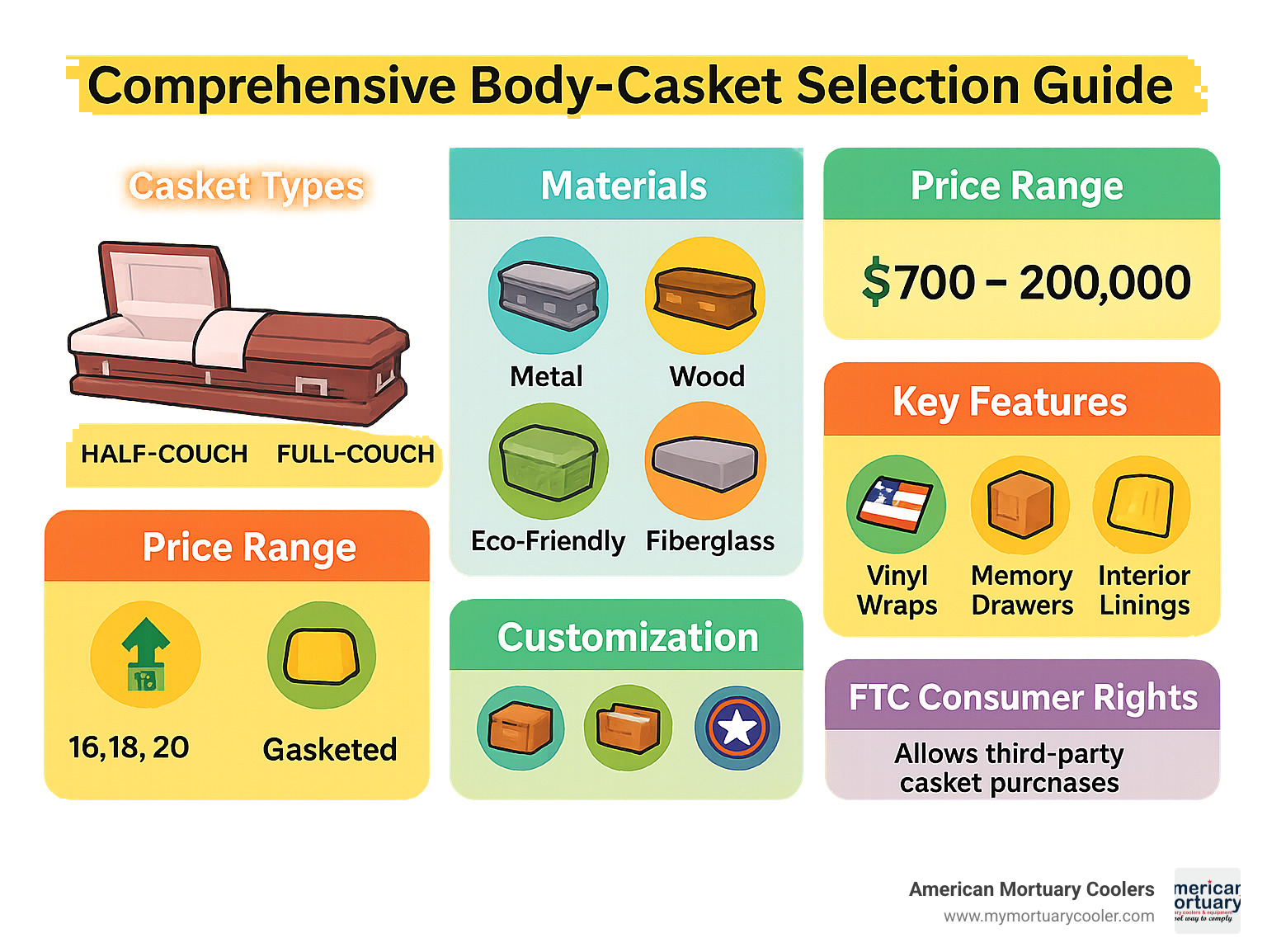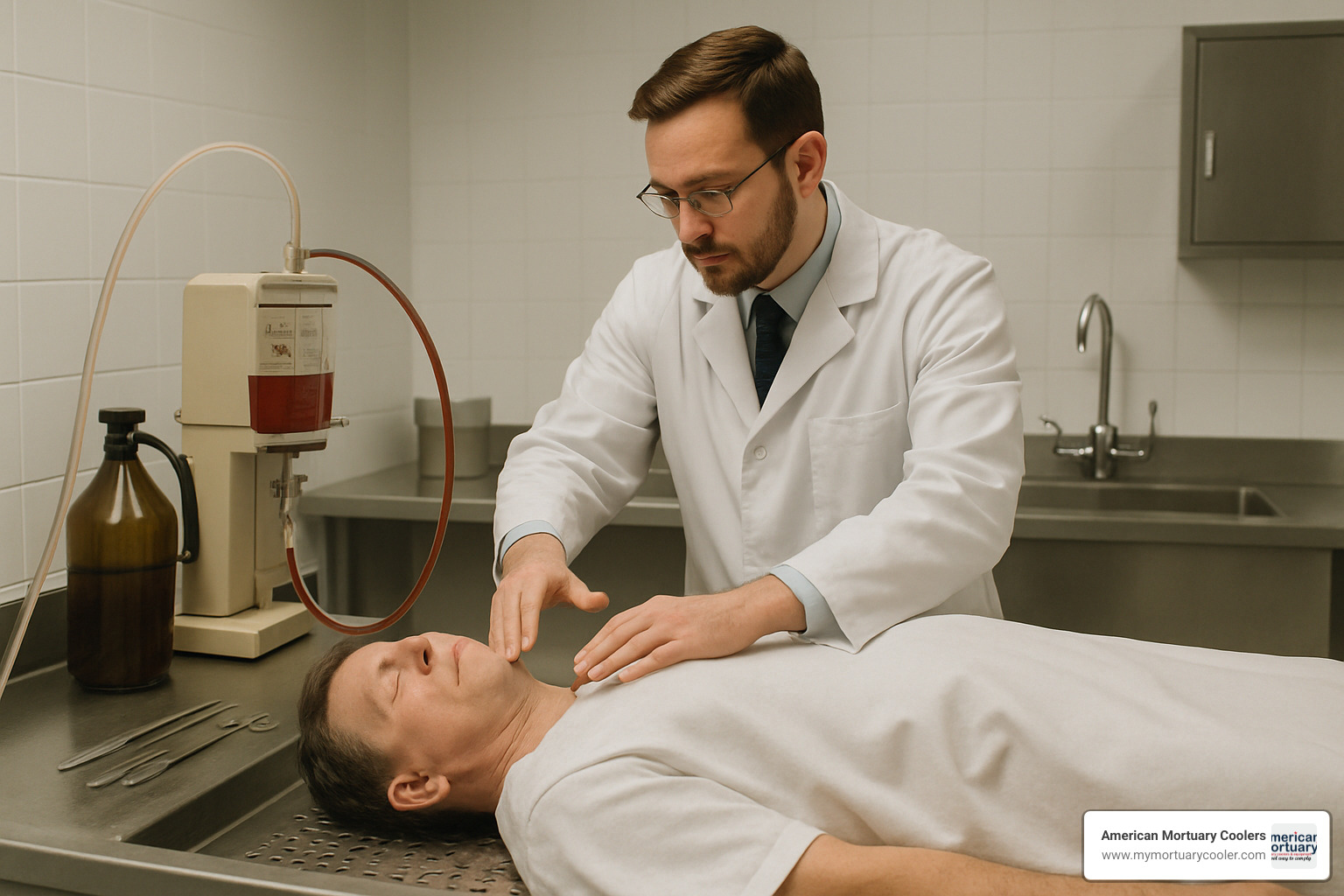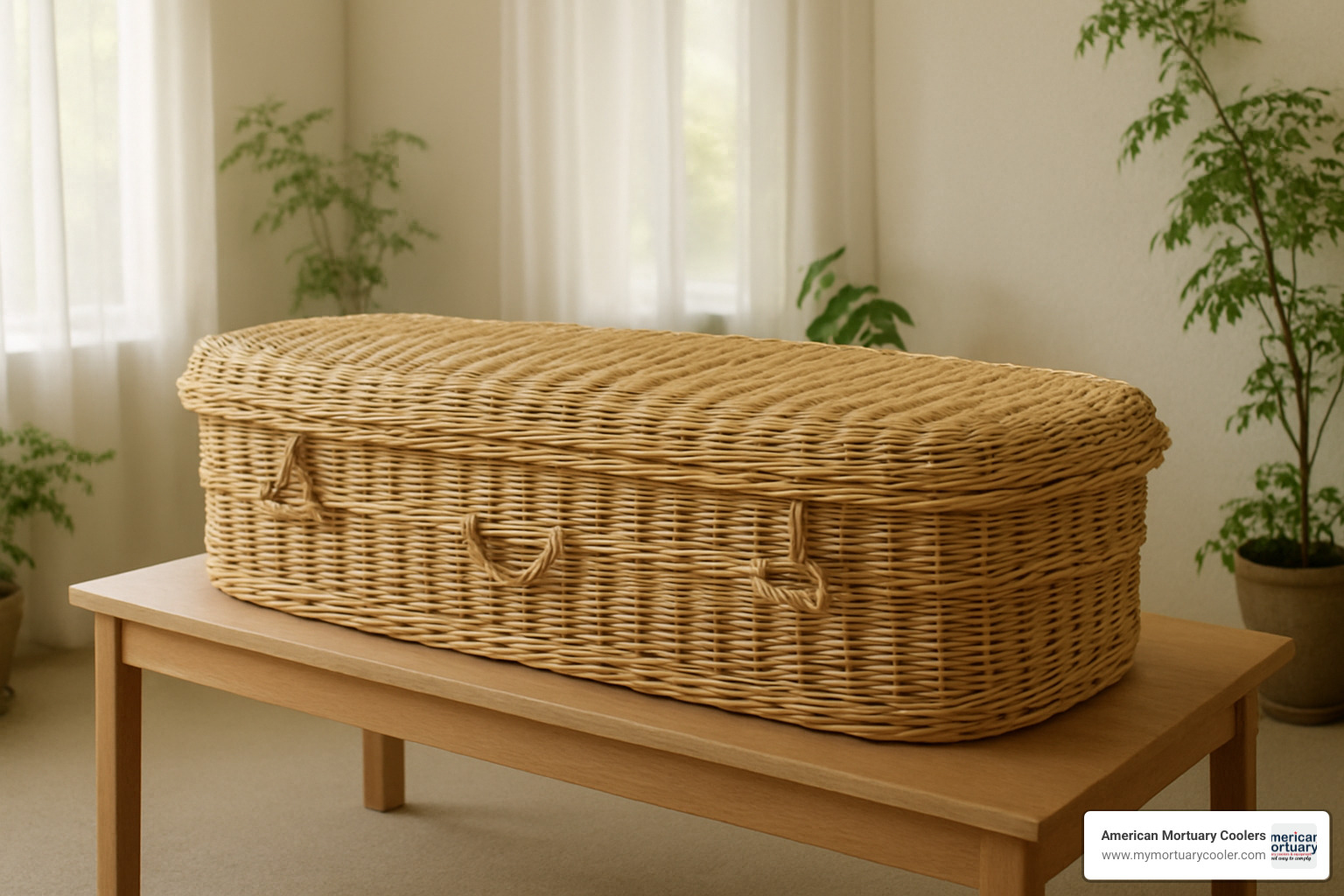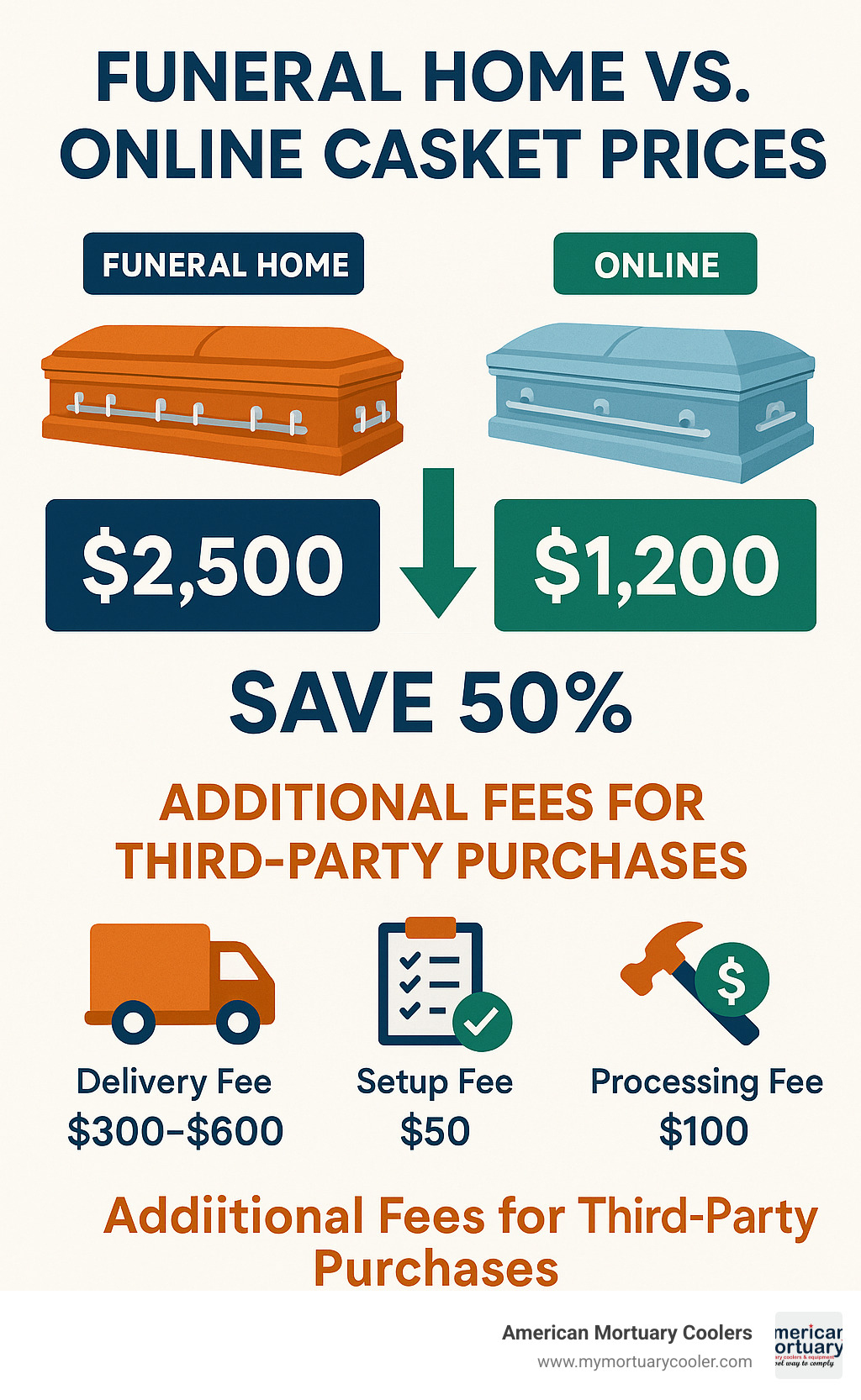
Everything You Need to Know About Body Casket Options
Understanding Body-Casket Options for Modern Funeral Services
Choosing the right body-casket for funeral services involves understanding materials, costs, regulations, and preparation methods that directly impact both family satisfaction and operational efficiency.
Quick Body-Casket Overview:
- Casket vs. Coffin: Caskets are rectangular; coffins are six-sided and tapered
- Materials: Wood, metal (steel/bronze/copper), fiberglass, eco-friendly options
- Price Range: $700-$20,000, with averages between $2,000-$5,000
- Key Features: Half-couch vs. full-couch lids, gasket seals, interior linings
- Legal Rights: FTC Funeral Rule allows third-party purchases, saving up to 85%
- Preparation: Embalming, cosmetics, clothing, temperature control affect appearance
When planning funeral services, funeral directors face complex decisions about body-casket selection. The average funeral home casket costs over $2,000, but online alternatives can reduce expenses by up to 85% while maintaining quality and dignity.
Bodies often look different in caskets due to embalming chemistry, temperature changes, and natural post-mortem processes. Embalming fluids react differently based on medications, cause of death, and body weight. Professional embalmers balance formaldehyde ratios with accessory chemicals to preserve natural appearance, though skill levels vary significantly between practitioners.
Modern body-casket options include:
- Metal caskets in 20-, 18-, or 16-gauge steel with rust-resistant finishes
- Hardwood varieties like mahogany, oak, cherry, and pine for traditional burials
- Eco-friendly alternatives using bamboo, willow, seagrass, or cardboard
- Rental systems with removable inserts for viewing services
- Customization features including vinyl wraps, memory drawers, and military insignia
The FTC Funeral Rule protects consumers by requiring funeral homes to accept third-party caskets without additional fees. This regulation enables families to purchase body-casket options online and ship directly to funeral homes, creating substantial cost savings.
As specialists at American Mortuary Coolers with experience in mortuary equipment and body-casket storage solutions, we've worked with funeral homes nationwide to optimize their refrigeration systems and casket handling processes.

Casket vs. Coffin: Shapes, Purposes, and History
When people hear "casket" and "coffin," they often think these words mean the same thing. But there's actually a fascinating story behind why we use different terms—and the shapes tell us a lot about history, practicality, and how Americans changed the way we think about death.
Coffins came first, and they look exactly like what you'd expect from old movies: six-sided and tapered, wider at the shoulders and narrower at the feet. People sometimes called this the "toe-pincher" design because of how it squeezed in at the bottom. This shape followed the natural outline of the human body and used less wood, which mattered when materials were expensive.
Then came the rectangular casket, and everything changed. This American invention gained popularity during the Civil War, when families desperately needed to transport bodies across long distances. The straight-sided, box-like design held up much better for Civil War transport than the traditional coffin shape.
The rectangular design also worked better with vault use—those concrete or metal outer containers that many cemeteries require today. Caskets fit more securely inside vaults, creating better protection from the elements. The rectangular shape also provided more interior space for padding, silk linings, and personal items.
| Feature | Coffin | Casket |
|---|---|---|
| Shape | Six-sided, tapered | Rectangular, four-sided |
| Lid | Single piece | Hinged, often split |
| Origin | Traditional European | 19th-century American |
| Material Usage | Less wood/metal | More material required |
| Interior Space | Body-contoured | Spacious, padded |
| Cost | Generally lower | Typically higher |
The Purpose Behind a Body-Casket
Every body-casket serves three essential purposes that go way beyond just holding the deceased.
Viewing protection comes first. A good casket creates the right environment for family and friends to say their final goodbyes. The controlled space protects the body during viewing periods, which can stretch over several days depending on family traditions and travel needs for distant relatives.
Disease control became critically important during historical outbreaks like cholera and influenza. Proper containment prevents the spread of pathogens and keeps funeral homes and cemeteries safe for everyone.
Psychological closure might be the most important function of all. Research shows that seeing a loved one in a dignified setting actually helps people process their grief. The casket creates a clear, physical boundary that helps mourners accept the reality of death while providing a beautiful space for final moments together.
Cultural & Historical Evolution
The story of how "coffin" became "casket" in America reveals a lot about how we've changed our relationship with death and mourning.
Victorian etiquette ruled funeral practices in the 1800s with strict rules about everything from casket selection to the number of pallbearers. The word switch happened during the late 1800s when funeral directors started calling coffins "caskets" instead. Why? Because "casket" originally meant a jewelry box—something precious and beautiful.
This U.S. terminology shift reflected how the funeral industry was becoming more professional and customer-focused. The biggest change came with the FTC Funeral Rule in 1984. This law requires funeral homes to accept caskets from outside suppliers without charging extra fees. Scientific research on consumer rights showed that families were often paying inflated prices because they had no other options during their time of grief.
Now families can shop around, compare prices, and potentially save thousands of dollars while still getting exactly the body-casket they want for their loved one.
Preparing the Body for the Casket: Science, Art, and Perception
Walking into a funeral home viewing room, many families notice their loved one looks different than they remember. This change isn't just in their imagination—it's the result of complex scientific processes that transform the body after death and during preparation for the body-casket.

Embalming forms the foundation of modern body preparation. Funeral directors inject formaldehyde-based solutions throughout the circulatory system to temporarily preserve tissue and prevent decomposition. Embalmers must carefully adjust chemical concentrations based on the person's medical history, medications, and cause of death.
The chemistry can be tricky. When formaldehyde mixes with hemoglobin in the blood, it sometimes creates grayish skin tones that require additional cosmetic work. People who took blood thinners or chemotherapy often present unique challenges, as these medications affect how preservation chemicals interact with body tissues.
Natural changes begin immediately after death and continue throughout the preparation process. Rigor mortis starts within 2-6 hours, causing muscles to stiffen as proteins cross-link. Meanwhile, livor mortis causes blood to pool in the lowest areas of the body, creating purple discoloration.
Temperature control plays a crucial role in preservation and family comfort. Our mortuary refrigeration systems maintain bodies at 38-40°F to slow decomposition between death and the funeral service. Even when removed for viewing, bodies remain noticeably cooler than living tissue.
The artistic side of preparation involves cosmetics, hair styling, and dressing the deceased. Skilled embalmers set facial features, apply makeup to restore natural coloring, and position the body in the body-casket for the most peaceful appearance possible.
Safety considerations add another layer of complexity. Scientific research on pacemaker safety shows that medical devices like pacemakers must be removed before cremation to prevent dangerous explosions.
Why Bodies Look Different in the Casket
The question families ask most often is simple: "Why doesn't this look like my loved one?" The answer involves several factors working together.
Medication interactions top the list of unexpected challenges. Blood thinners, chemotherapy drugs, diabetes medications, and even common prescriptions can dramatically affect how embalming chemicals work.
Lighting creates subtle but important changes in how we perceive skin tone and facial features. Funeral homes use soft, warm lighting to create a peaceful atmosphere, but this can make skin appear different than it did under natural sunlight.
Embalmer skill varies significantly across the industry. Experienced professionals understand how to adjust their techniques for different body conditions, medical histories, and family preferences.
Cold & Stiff: Understanding Post-Mortem Changes
The characteristic coldness and stiffness that mourners notice aren't just cultural associations—they're the result of real biological changes that occur after death.
Body temperature drops rapidly once circulation stops. The normal 98.6°F body temperature falls to match the surrounding environment. Our refrigeration units maintain morgue temperatures around 38-40°F, and even when bodies are moved to warmer viewing rooms, they retain that coolness for hours.
Muscle stiffness develops through protein changes that occur in muscle fibers after death. This rigor mortis process is irreversible and contributes to the rigid feel that mourners notice when touching hands or faces. The stiffness affects how embalmers position the body in the body-casket.
Understanding these scientific realities helps families prepare emotionally for their final goodbye while appreciating the complex work that goes into creating a dignified farewell.
Body-Casket Types, Materials, and Costs
When families walk into a funeral home, they're often overwhelmed by the sheer variety of body-casket options available. Understanding the basics can help you steer these choices with confidence.
Metal caskets dominate American funeral homes for good reason. Steel caskets come in three main thicknesses: 20-gauge (the most economical), 18-gauge (the sweet spot for most families), and 16-gauge (premium quality that feels substantially heavier). The gauge number works backwards—lower numbers mean thicker, stronger steel.
For families wanting the ultimate in durability, bronze and copper caskets offer superior corrosion resistance. Many metal caskets feature rubber gasket seals that create an airtight closure, though ironically, this can sometimes accelerate decomposition by creating anaerobic conditions.
Wood caskets bring warmth and tradition that many families find comforting. Hardwoods like mahogany, oak, cherry, and walnut showcase beautiful grain patterns and offer impressive durability. For budget-conscious families, pine and poplar provide the natural wood appearance without the premium price tag.
Beyond traditional materials, alternative options serve specific needs. Fiberglass caskets are lightweight yet durable, available in colors that metal can't match. Cloth-covered caskets wrap fabric around wood or fiberboard cores, creating a softer appearance. For families considering viewing followed by cremation, rental caskets with removable inserts provide dignity during services without the full expense.

The price spectrum for body-casket options spans an enormous range. Budget-friendly choices start around $700-$1,500 for basic wood or cloth-covered models. Mid-range options between $1,500-$5,000 include quality hardwoods and standard metal caskets. Premium caskets can reach $20,000 or more for exotic woods or elaborate metal designs. However, online purchasing can reduce costs by up to 85% compared to funeral home prices, thanks to FTC regulations.
Choosing the Right Body-Casket for Burial vs. Cremation
The final disposition significantly impacts your body-casket selection, and understanding these differences can save both money and disappointment.
Burial caskets need to withstand time and elements. Metal or hardwood construction provides the structural integrity for long-term burial. Gasket sealing systems offer protection from soil and moisture. Most cemeteries accommodate standard dimensions (84" × 28" × 23"), but oversized options up to 31" width serve larger individuals with dignity.
Cremation requirements are entirely different. The crematory can only accept completely combustible materials—wood, cardboard, or specialized cremation containers. No metal parts, hinges, or handles are allowed, as they can damage crematory equipment.
For families planning cremation, simple containers significantly reduce expenses when viewing isn't planned. However, rental caskets with removable inserts allow beautiful viewing services followed by cremation, combining dignity with economy.
The half-couch versus full-couch design affects both viewing and costs. Half-couch caskets feature split lids that open to reveal the upper body while covering the legs. Full-couch caskets open completely to reveal the entire body.
For families seeking economical options without sacrificing quality, Affordable Pine Box Caskets for Every Budget offers detailed guidance on dignified, budget-friendly choices.
Eco-Friendly Body-Casket Alternatives
Environmental consciousness increasingly influences body-casket selection, with families seeking options that honor both their loved ones and the earth.
Biodegradable materials offer beautiful alternatives to traditional caskets. Bamboo caskets showcase attractive grain patterns while using rapidly renewable resources. Hand-woven willow creates unique, artistic appearances. Seagrass caskets provide cultivated materials that decompose naturally without requiring burial vaults.
Cardboard caskets might sound humble, but modern designs offer surprising dignity and strength for both direct burial and cremation. These economical options often cost less than $200 while meeting all functional requirements.
Green burial benefits extend beyond individual choices. These materials decompose completely in soil without toxic chemicals or non-biodegradable components. They're compatible with natural burial grounds and conservation cemeteries that preserve land while providing meaningful resting places.
The growing availability of eco-friendly options means families no longer need to choose between environmental values and meaningful farewells. Many of these alternatives cost significantly less than traditional caskets while providing unique beauty and personal meaning.
Customization, Legal Rights, and Smart Buying Tips
When families face the difficult task of selecting a body-casket, they often don't realize how much control they actually have over both the buying process and personalization options.
Your legal protections are stronger than you might think. The Federal Trade Commission's Funeral Rule gives you powerful consumer rights that can save thousands of dollars. Funeral homes must accept any casket you purchase from outside sources—and they can't charge you extra handling fees. They also have to provide written price lists when you ask, and they can't make false claims about how well different caskets preserve bodies.
These protections exist because the funeral industry had serious problems with overcharging grieving families. Now you can shop around, compare prices, and potentially save up to 85% by purchasing your body-casket online or from third-party retailers.
The customization possibilities are remarkable. Modern casket manufacturers offer steel caskets in over 20 exterior colors, from traditional bronze and silver to vibrant blues and deep burgundies. Interior fabrics range from classic velvet and satin to specialty materials that reflect personal tastes. Hardware options include different handle styles, corner designs, and hinge finishes in various metals.
Engraving services let you add nameplates, religious symbols, military insignia, or personal messages that celebrate your loved one's unique life. Some families choose corner emblems that represent hobbies, professions, or organizational memberships.
Smart shopping strategies make a real difference. Online casket retailers often offer the same quality products as funeral homes at dramatically lower prices. Even with delivery fees of $300-$600, you'll typically save thousands compared to funeral home markup.
For more detailed guidance on cost-effective options, check out The Complete Guide to Rental Casket Options, which explains how rental systems can reduce expenses while maintaining dignity for viewing services.
Personalizing a Body-Casket
The most touching funeral services often feature personalized caskets that tell a story about the person inside. Modern technology makes this personalization easier and more affordable than ever before.
Vinyl wraps have revolutionized casket customization. Computer-designed graphics can transform a standard casket into a unique work of art. We've seen caskets featuring everything from military service photos to favorite fishing spots, from religious imagery to beloved pets.
Memory features add special touches that comfort families. Memory drawers provide small compartments for keepsakes, letters, or photographs that family members want to keep with their loved one. Memory tubes serve as identification systems for cemetery records while also holding personal mementos.
Interior customization creates a personal resting place. Families can choose fabric colors and textures that match their loved one's favorite colors or personality. Custom embroidered pillows might include the person's name, birth and death dates, or a meaningful phrase.
The key to successful personalization is balancing meaningful touches with tasteful presentation. The best customized caskets feel like authentic tributes rather than overwhelming displays.
Saving Money Without Sacrificing Meaning
Nobody wants to feel like they're cutting corners during such an important time, but smart financial decisions can actually improve rather than diminish the meaningfulness of funeral services.
Third-party purchasing offers the biggest savings opportunity. Thanks to FTC protections, you can shop online casket retailers, local casket showrooms, or even warehouse stores that sell caskets. The funeral home cannot refuse your casket or charge extra fees for accepting it. This single decision can save thousands of dollars.
Rental strategies work beautifully for many families. Rental caskets feature removable interior inserts that allow dignified viewing services followed by cremation or burial in simpler containers. This approach can reduce casket costs by 70-90% while maintaining the dignity and beauty families want.
Price comparison shopping requires some effort but pays off significantly. Request itemized price lists from multiple funeral homes and compare them with online alternatives. Don't forget to factor in delivery fees, setup charges, and any other associated costs.
At American Mortuary Coolers, we work with funeral homes to ensure their casket storage and handling systems maintain proper temperature control and dignified presentation regardless of where families purchase their body-casket.

Frequently Asked Questions about Body-Caskets
We get these questions all the time from families and funeral directors. Let's tackle the three most common concerns about body-casket selection and purchasing.
What is the average cost of a body-casket?
The honest answer? It depends on where you shop and what matters most to your family. Most body-casket purchases fall between $2,000 and $5,000, though prices can range anywhere from $700 to over $20,000.
Here's where it gets interesting: funeral homes typically mark up caskets significantly, but online alternatives can slash your costs by up to 85%. We've seen families save thousands by purchasing directly from third-party suppliers.
Material makes a big difference in pricing. Steel caskets typically start around $999, while wood options begin at $799. Cloth-covered models offer the most budget-friendly choice at $679 and up. The construction quality—like gauge thickness for metal or wood species for wooden caskets—dramatically affects the final price.
Features add up quickly too. Gasket seals, premium interior linings, high-quality hardware, and customization options can double or triple the base price. Brand reputation and retailer markup play huge roles in what you'll pay.
Don't forget delivery costs when shopping online. Most third-party suppliers charge $300-$600 for shipping, but even with delivery fees, the savings remain substantial compared to funeral home prices.
Do metal caskets really preserve the body longer?
This might surprise you, but no—metal caskets don't preserve bodies longer. In fact, those "protective" gasket seals might actually speed up decomposition. It's one of the biggest misconceptions we encounter in the funeral industry.
Here's what actually happens: gasket seals create airtight environments that trap moisture and gases inside the casket. Instead of protecting the body, this creates conditions that can make decomposition worse. Some mausoleums actually break the rubber seals on metal caskets specifically to prevent this problem.
The marketing around "protective" caskets refers to protecting the casket itself from soil and moisture—not preserving the person inside. Bronze and copper caskets resist corrosion better than steel, which means the casket lasts longer underground. But this doesn't affect what happens to the body at all.
The truth is, no casket material or feature can preserve a body indefinitely. The embalming process and burial environment have much greater impact on preservation than whether you choose wood, steel, or premium metals. Natural decomposition is a normal biological process that happens regardless of casket type.
Can I supply my own body-casket to the funeral home?
Absolutely, and it's completely legal. The Federal Trade Commission's Funeral Rule guarantees your right to purchase a body-casket from any source you choose. Funeral homes must accept your casket without charging extra handling fees.
This protection exists because the funeral industry used to prevent families from shopping around. Now, funeral homes cannot charge handling fees for third-party caskets, and they must accept any casket that meets basic safety and size requirements. They're also required to provide written price lists upon request and can't mislead you about preservation claims or legal requirements.
Planning ahead makes the process smoother. Coordinate delivery timing with your funeral home to ensure everything arrives when needed. Make sure your chosen casket meets any specific cemetery or crematory requirements—some facilities have size restrictions or material limitations.
Check the dimensions carefully to ensure the casket will fit the funeral home's existing equipment and facilities. Most suppliers who work with funeral homes understand these requirements and can guide you through the process.
Quality matters when shopping online. Purchase from reputable suppliers who understand funeral industry standards and can provide proper documentation and reliable delivery services. The savings are real—we've seen families cut their casket costs by thousands while still honoring their loved ones with dignity and respect.
Conclusion
Choosing the right body-casket doesn't have to feel overwhelming when you understand the basics. Whether you're drawn to a traditional mahogany casket or considering an eco-friendly bamboo option, the perfect choice balances what your heart needs with what your budget allows.
The most important thing to remember? You have more control than you might think. The FTC Funeral Rule gives you real power to shop around, compare prices, and save thousands of dollars without sacrificing dignity or meaning. Many families find they can honor their loved ones beautifully while keeping 85% of their money in their pockets instead of paying funeral home markups.
Understanding why bodies look different in caskets—from embalming chemistry to natural cooling—helps prepare you for that final goodbye. It's completely normal for your loved one to feel cold or look slightly different. These changes don't diminish their memory or your love.
Modern body-casket options truly offer something for everyone. Traditional families might choose a steel casket with protective seals, while environmentally conscious families lean toward willow or seagrass alternatives. Military families can add insignia and honor guards, while others focus on memory drawers filled with personal treasures.
At American Mortuary Coolers, we've spent years helping funeral homes across the country create the right environment for these important moments. Our custom mortuary coolers, built right here in Tennessee, ensure that every body-casket presentation maintains the dignity and respect your family deserves.
The funeral industry has changed dramatically over the past few decades, mostly in your favor. You can purchase caskets online, customize them with personal touches, and work with funeral directors who understand your rights and respect your choices.
For personalized guidance on mortuary equipment and body-casket storage solutions that serve funeral homes nationwide, visit mymortuarycooler.com. We're here to support the funeral professionals who help families create meaningful farewells, one custom refrigeration system at a time.



